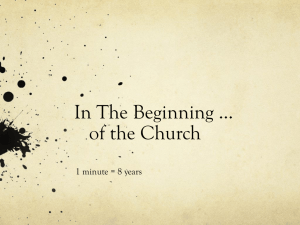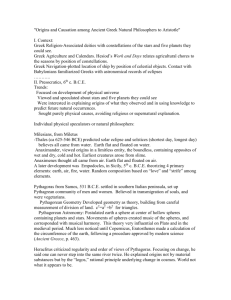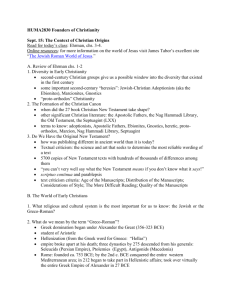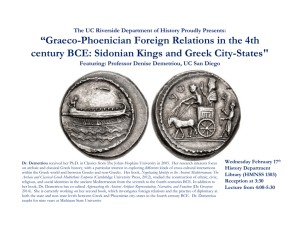Israel in the Hellenistic Age - Greek Language and Linguistics
advertisement
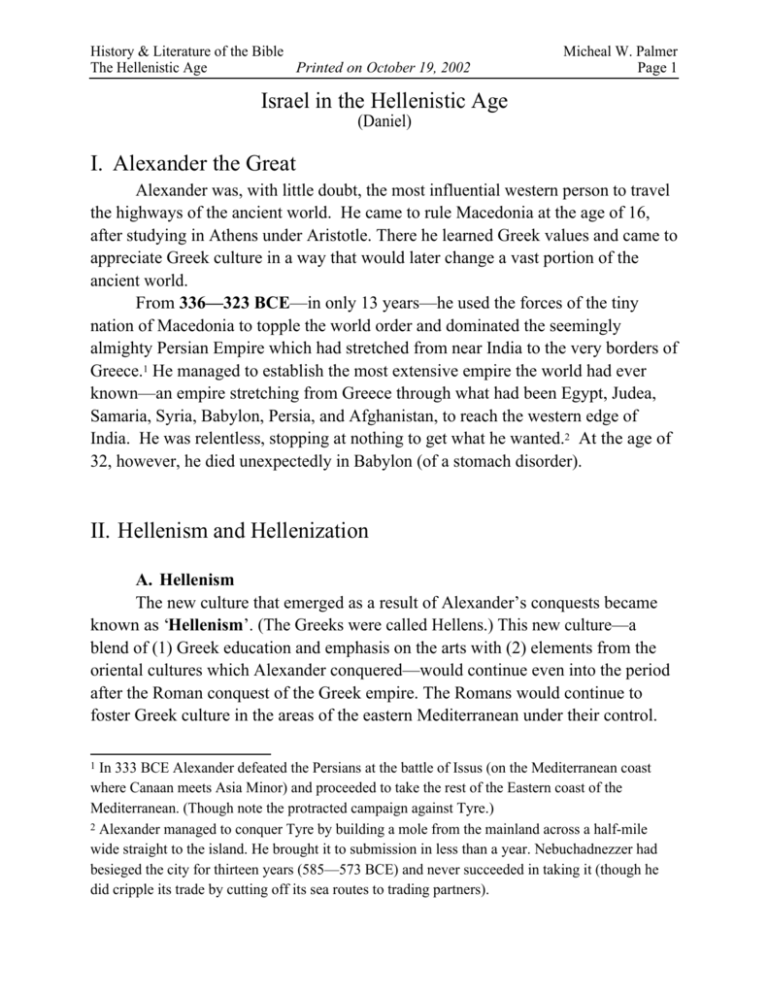
History & Literature of the Bible The Hellenistic Age Printed on October 19, 2002 Micheal W. Palmer Page 1 Israel in the Hellenistic Age (Daniel) I. Alexander the Great Alexander was, with little doubt, the most influential western person to travel the highways of the ancient world. He came to rule Macedonia at the age of 16, after studying in Athens under Aristotle. There he learned Greek values and came to appreciate Greek culture in a way that would later change a vast portion of the ancient world. From 336—323 BCE—in only 13 years—he used the forces of the tiny nation of Macedonia to topple the world order and dominated the seemingly almighty Persian Empire which had stretched from near India to the very borders of Greece.1 He managed to establish the most extensive empire the world had ever known—an empire stretching from Greece through what had been Egypt, Judea, Samaria, Syria, Babylon, Persia, and Afghanistan, to reach the western edge of India. He was relentless, stopping at nothing to get what he wanted.2 At the age of 32, however, he died unexpectedly in Babylon (of a stomach disorder). II. Hellenism and Hellenization A. Hellenism The new culture that emerged as a result of Alexander’s conquests became known as ‘Hellenism’. (The Greeks were called Hellens.) This new culture—a blend of (1) Greek education and emphasis on the arts with (2) elements from the oriental cultures which Alexander conquered—would continue even into the period after the Roman conquest of the Greek empire. The Romans would continue to foster Greek culture in the areas of the eastern Mediterranean under their control. 1 In 333 BCE Alexander defeated the Persians at the battle of Issus (on the Mediterranean coast where Canaan meets Asia Minor) and proceeded to take the rest of the Eastern coast of the Mediterranean. (Though note the protracted campaign against Tyre.) 2 Alexander managed to conquer Tyre by building a mole from the mainland across a half-mile wide straight to the island. He brought it to submission in less than a year. Nebuchadnezzer had besieged the city for thirteen years (585—573 BCE) and never succeeded in taking it (though he did cripple its trade by cutting off its sea routes to trading partners). History & Literature of the Bible The Hellenistic Age Printed on October 19, 2002 Micheal W. Palmer Page 2 B. Hellenization The process of fostering the new Greek culture became known as ‘Hellenization.’ Alexander and his successors employed several tactics designed to further the spread of Hellenism. They (1) established Greek cities (run under the ‘democratic’ Greek model), (2) imposed the Greek language as the official language for government and the de facto language for commerce. (3) They established Greek schools (Gymnasia) to further the values of Greek culture and built Greek temples, stadiums, and theaters for the same purpose. In the years under Greek rule the world of the Jewish people would begin a process of change that would arguably be the most radical yet. The clear influence of Greek values, architecture, commerce, and language can be seen beginning in this period even in Judea. Many people began to give their children Greek names, and local styles of art and architecture began to imitate Greek models. Even some of the Jewish High Priests took Greek names. Outside Judea Greek would become the lengua franca of the Jewish communities, and the Septuagint translation of Bible would be produced (perhaps as early as 250 BCE) to meet the needs of those communities. In time it was only natural that the pressure to conform to Greek values and the changing nature of Jewish society would come into direct conflict with Judaism—the faith of the Jewish people. Rebellion against the powerful Greeks, though, would be out of the question for a very long time. III. The Hellenistic Kingdoms A. Introduction: The Rise of the Seleucid and Ptolemaic Kingdoms When Alexander died, his empire was divided among his five generals. Of these, two will concern us. Ptolemy (pronounced TOE-lemee) gained control of Egypt (along with most of the rest of north Africa), most of what would later be called Palestine, and the Mediterranean Sea. He established the Ptolemaic dynasty. Seleucus got Syria and most of the northern half of Alexander’s empire and established the Seleucid dynasty. In 198 BCE, the Seleucid ruler, Antiochus of Syria took the Jewish kingdom away from the Ptolemies.3 3 The decisive moment was the battle of Paneas, 198 BCE. History & Literature of the Bible The Hellenistic Age Printed on October 19, 2002 Micheal W. Palmer Page 3 Under the Ptolemies, the people of Israel had enjoyed relative peace. They were allowed to practice their religion without much interference. Under the Seleucids this same policy of tolerance was maintained at first, but under Antiochus IV, things began to change. B. Antiochus IV’s Persecution of the Jews Antiochus IV (who called himself Epiphanes—“God manifest”) took power in 175 BCE, 30 years after the Seleucid conquest of what would later be known as Palestine.4 He had ambitions of reestablishing Alexander’s empire under his own rule, and had little regard for the religion of the Jewish people. Antiochus upset the line of succession of the high priests by appointing Joshua (who then took the Greek name, Jason) in place of his brother Onias for a bribe, then deposing Jason and appointing Menelaus (again, notice the Greek name) for a bigger bribe. This sequence of events brought to an end the old Zadokite line of High Priests. Antiochus IV attacked the Ptolemaic kingdom in Egypt and defeated them. To his surprise, however, the Romans also landed in Egypt shortly after his arrival and forced him to return rule to the Ptolemies. On his way back through Israel, he desecrated the Temple in Jerusalem, sacrificing pigs on the alter (167 BCE). He set up an alter to Zeus, and prohibited Sabbath observance, circumcision, reading of the Torah, and celebration of religious festivals—in short, he outlawed Judaism, seeing the Jews as a threat to his kingdom (a theme which would reemerge in modern times under Hitler). His actions were strikingly inconsistent with the attitude of tolerance that usually characterized Hellenistic culture. Amazingly, many of the Jews welcomed he changes Antiochus imposed. Some seemed to be saying, “It’s about time we caught up with the rest of the world and abandoned all of those ancient customs of ours.” They took on Greek values, Greek names, Greek dress, and adopted a Greek diet. Others, however, did not see matters the same way—especially many of the peasants in the countryside. A group called the Hasidim (the “pious ones”) emerged in this period out of the resistance to these changes. 4 Antiochus IV ruled from 175—163 BCE History & Literature of the Bible The Hellenistic Age Printed on October 19, 2002 Micheal W. Palmer Page 4 IV. The Maccabean Revolt (166—141 BCE) When Antiochus IV saw that his policies were not being implemented in the outlying areas, he sent messengers to each village to force the local priests to sacrifice to Zeus. If a priest refused, he was simply replaced by someone willing to perform the sacrifice. When Antiochus’ emissary arrived in the village of Modein the local priest, Mattathias, refused to perform the sacrifice. Antiochus’ messenger asked for a volunteer. Since the job of priest was one with considerable influence, it did not take long to find a replacement. When a young man stepped forward to perform the sacrifice, however, Mattathias struck him dead. He then turned on Antiochus’ messenger and killed him too. When Mattathias had had a few minutes to think about the implications of what he had done, he decided a change of residence was in order. In a state of near panic, he gathered his five sons together and headed for the hills (literally). Soon hundreds of others joined them there. (They realized it wouldn’t be long before Antiochus’ troops leveled Modein anyway.) Over the next few months, more and more people from the countryside joined Mattathias and his sons in the hills of Judea. Many of these were Hasidim. From the hills they began the first campaign of guerrilla warfare, darting down into the valley for lightening attacks on the Seleucid troops and rushing back into the mountains to evade capture. By 164 BCE, Mattathias’ son, Judas (called Maccabeus, meaning “the hammer—hence the Maccabean Revolt), had recaptured Jerusalem. In the month of Kislev (December) of 164 BCE he cleansed and rededicated the Jerusalem Temple of the God of Israel. To this day Jewish communities world wide celebrate that day. They call it Hanukkah. (It has also been called the ‘Feast of Lights,’ and ‘The Feast of Dedication’.) When Judas rededicated the Temple, many of the Hasidim abandoned the war effort. They had what they wanted (the right to worship their God) and were not interested in the further political goal of ousting the Seleucids completely. From that time on the revolt continued with reduced forces, but in 143—142 BCE, Judas’ brother, Simon, led the revolt to political independence as well. At this point the war ended and Simon declared himself both High Priest and king, a move that would bring political unrest later, since he was from the wrong family for both offices. (He did not, as some may have expected, reestablish the Zadokite line which Antiochus IV had ended.) He died in 135 BCE History & Literature of the Bible The Hellenistic Age Printed on October 19, 2002 Micheal W. Palmer Page 5 V. The Hasmonean Period (142—63 BCE) The period from 142 (the date of independence) to 40 BCE (the beginning of the reign of Herod the Great under the Romans) is called the Hasmonean period, because the ruling family—the family of Mattathias and his sons Judas, Jonathan, and Simon—was the house of Hasmon. After Simon, the Hasmonean rulers took Greek names, with the effects of hellenization still strongly felt. This period was torn by political in-fighting, as civil unrest broke out often over who would succeed the previous Hasmonean ruler. In 63 BCE, John Hyrcanus II would have been the logical heir to the throne, but his brother Aristobulus II out maneuvered him and took his place through a series of carefully constructed alliances. Hyrcanus, not wanting to let his brother steal his throne, called on the Romans, who by now controlled all of the Mediterranean world but the area immediately around Israel. The Romans, of course, were glad to help. They sent Pompey to oust Aristobulus II and put John Hyrcanus II in power, naming him High Priest and Ethnarch. They then informed him that he now worked for Rome. When John Hyrcanus II died the Romans had little interest in continuing the Hasmonean line. In 40 BCE they appointed the first of the Herods, one who would later be called “Herod the Great”, as a client king with a territory roughly equivalent in size to what Israel had been under David and Solomon. He and his successors served Rome under the authority of the Roman Governor of Syria. VI. The Book of Daniel and Apocalyptic Literature Most modern critical biblical scholars believe that the book of Daniel was written during the Hellenistic Period, though the story that it tells is clearly set in a much earlier time. The practice of writing works in a way which would sound like they were written much earlier was well established by this period, so it should not surprise us to find examples in the Bible. A. Apocalyptic Literature Part of the book of Daniel is written in apocalyptic style, a way of writing which involves a great deal of symbolism and a dualistic outlook. Be sure you History & Literature of the Bible The Hellenistic Age Printed on October 19, 2002 Micheal W. Palmer Page 6 have read the treatment of apocalyptic literature on pages 316—320 of Harris’ book. B. The Book of Daniel The book of Daniel is easily divided into two sections. Chapters 1—6 tell a set of stories about Daniel and his three friends set in Babylon to which they had been deported in the third year of Kind Jehoiakim of Judah (606 BCE).5 The story bears many parallels with earlier Jewish literature. Daniel proves his devotion to God when put to the test. He is given a position of leadership in a foreign government after interpreting dreams (as in the Joseph story). He and his friends suffer the effects of court intrigue (as in Esther). The rest of the book (chapters 7—12) contains four apocalyptic visions indicating what is to happen later. The details of chapters 10—11 especially are cast in terms that fit well with the events leading up to and including the profanation of the Jerusalem Temple under Antiochus IV in December of 167 BCE (See 11:31). While the book alludes to the death of Antiochus, it does not mention the rededication of the Jerusalem Temple (which took place in 164 BCE). This omission leads many scholars to believe that at least chapters 7—12 were written earlier that year. VII. Herod the Great and His Successors A. Herod the Great (40 [37?]—4 BCE) Many of the Jewish people did not want Herod to rule over them. It took three years from the time he was named King by the Roman Senate in 40 BCE for him to actually take control of Palestine. He had to fight his way to the throne. By 37 BCE he had captured Jerusalem and begun his long reign, which would end with his death in 4 BCE.6 5 We have no other evidence for this deportation, which comes before the fall of Jerusalem in 587 BCE. 6 Note the historical issue raised by this date. Jesus was born during the reign of Herod the Great. The inventors of our modern (Gregorian) calendar miscalculated Herod’s reign by about six (6) years. Jesus was born somewhere between what our mistaken calendar calls 6 and 4 BCE. History & Literature of the Bible The Hellenistic Age Printed on October 19, 2002 Micheal W. Palmer Page 7 Herod the Great was the son of an Idumean (Edomite) man and a Jewish woman, but his father’s not being Jewish was probably not the reason that the people resisted his rule. In fact, according to later rabbinic thought, his mother being Jewish would make him Jewish. The more likely reason for the resistance to his rule is that they knew what type of person Herod was and what kind of ruler he would be. He ruled with an iron hand. Palestine prospered greatly under his rule, but Caesar Augustus is quoted by Josephus as saying “I’d rather be Herod’s pig than his son” (INSERT GK TEXT HERE) since Herod was insanely jealous of his position.7 He was loyal to the Romans and even built temples to Augustus in other places while renovating the temple to the God of Israel in Jerusalem. Herod sought to buy favor with the people by embarking on the most ambitious building program in the history of Palestine. He set about to make the Temple even more glorious than in the days of Solomon.8 Herod wanted to build a structure that people would travel from all over the empire to see. The mountain upon which the Temple sat was too small, so he extended it in three directions to accommodate the immense structure that the Temple would become. This renovated Temple, sometimes called “Herod’s” Temple, was the building through which Jesus walked as he taught his disciples. In addition to his impressive renovation of the Temple, Herod founded Caesarea as his capital and the main port for the region and rebuilt the city of Samaria under the new name ‘Sebaste’ (the Greek equivalent of ‘Augustus’). He also built aqueducts throughout Palestine to bring water to the parched land from the mountains. Shortly before Herod the Great’s rule the Parthians, who had reestablished much of the old Persian Empire, tried to take Palestine back from the Romans (44 BCE). They even tried to put the Hasmoneans back in power in Israel. Herod, no doubt, had to contend with pressure from people with Parthian ties. B. Herod’s Successors When Herod died in 4 BCE, his territory was divided between three of his sons: Philip, Herod Antipas, and Herod Archelaus. Herod Archelaus got Judea, 7 Josephus claims that he drowned his own teenage son in the family pool because he might one day be a political rival. 8 Solomon’s Temple had been destroyed by the Babylonians in 587 BCE. When the Jews returned from exile in Babylon, they rebuilt the temple, but not nearly to the standard of what had been there in the time of Solomon. History & Literature of the Bible The Hellenistic Age Printed on October 19, 2002 Micheal W. Palmer Page 8 Samaria, and Idumea, but he was an incompetent and overbearing ruler whom the Romans soon threw out and replaced with a similarly incompetent Roman Procurator—thus placing Judea, Samaria, and Idumea under direct Roman rule. They also threw out this procurator, his successor, and so on for the next thirty or so years. Finally the Romans found the right person for the job in Pontius Pilate, who took control of these three areas in 26 CE. Herod Antipas (the Herod referred to in the New Testament stories of Jesus’ trials and crucifixion) got Galilee and Perea. His rule was stable for all of this turbulent period. His brother, Philip got the area to the north and east of the Sea of Galilee. Two of these rulers will interest us greatly when we discuss the New Testament period. When Jesus was arrested and tried, Pontius Pilate ruled Judea and Samaria directly for the Romans. Herod Antipas ruled Galilee and Perea as a client king. In the Gospel accounts it is clear that no one wants to take responsibility for Jesus’ case. Why not? Perhaps Pilate was afraid that if he condemned Jesus, Jesus’ own followers would revolt, yet if he didn’t, maybe Jesus’ enemies would start a revolt. In either case, he knew what the Romans did with those who could not maintain control, so when he learned that Jesus was from Galilee, he sent him to Herod Antipas, who happened to be in Jerusalem for the Passover celebration. Antipas was no idiot, though. He sent Jesus back to Pilate. VIII. The Jewish Revolts Against Rome Long after the death of Jesus, the Jewish people would rebel twice against Rome. The first rebellion, which lasted from 66—73 CE (though a few Zealots held out until 74), resulted in the capture of Jerusalem and the destruction of its Temple (70 CE). The second revolt (132—135 CE) brought even more disastrous results. The region of Judea was devastated; Jerusalem was destroyed then rebuilt as a pagan city, with the Jews expelled from the region. There would be no Jewish state in Palestine, even under foreign domination, from that time until the modern state of Israel was established in 1948. History & Literature of the Bible The Hellenistic Age Printed on October 19, 2002 Micheal W. Palmer Page 9 A. The First Jewish Revolt (66—70 CE) In 66 CE Jewish nationalists revolted against Rome. Nero—the ruling emperor at that time—sent Vespacian, who captured Galilee easily. In 68 CE Nero was driven from power and committed suicide. Vespacian became the new Emperor and left Titus in charge of the Jewish war. Titus sacked Jerusalem in August of 70 CE and tore down the Jewish Temple (which has never been rebuilt since). Most of our knowledge of this war comes from Flavius Josephus, a Jewish general in the early part of the revolt. To save his life when he was captured by the Romans, he claimed to have seen a vision which indicated that Vespacian would soon become Emperor. Josephus wrote two works that have survived and are now a significant source for reconstructing the history of this period in Palestine. The Jewish War recounts the story of the rebellion, while Antiquities of the Jews tells the broad story of Jewish history including the events of the first Jewish revolt against Rome. B. The Second Jewish Revolt (132-135) A second Jewish revolt against Rome came in 132-135 CE. It was lead by Bar Kochba (‘Son of the Star’). The rebellion was brutally suppressed by Hadrian, who sacked Jerusalem again in 135 CE. After this revolt the Jews were forbidden to enter Jerusalem, and it was rebuilt as a pagan city. IX. Summary & Conclusions Alexander the Great changed the world in which the people of Israel would have to live. Hellenization shaped the intellectual and cultural environment in ways which would make the later world into which Christianity was born very different from the world in which the faith of Israel had its beginnings. The book of Daniel seems to date from the Hellenistic period, and certainly discusses events from both the Persian and Hellenistic periods, though in the typical symbolic fashion of apocalyptic literature. Several of the books of the Apocrypha/Deuterocanon give additional evidence for the Hellenistic period, a period in which the Greek language and culture came to dominate many aspects of the biblical world.

